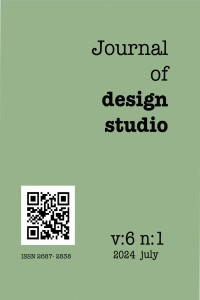Dreaming of Better Spaces: Environmental Psychology in Students' Redesign of Interior Architecture Studios
Abstract
This study looks at interior design students' perceptions and remodeling ideas for their studio spaces through the lens of environmental psychology. It evaluates 10 student groups' proposals, with a focus on spatial layout, usefulness, aesthetics, and the emotional impact of the designed places. Key themes include ergonomic furniture, spatial zoning, color scheme preferences, and the incorporation of natural components. The study emphasizes students' need for multifunctional studio spaces that elicit good emotional responses and improve their sense of well-being. It also highlights the changing nature of interior design education, as students prefer ergonomic seats over stools. The findings highlight the necessity of incorporating students in the design of their learning environments, thereby connecting theory with real-world applications.
Keywords
Environmental Psychology Human Centered Design Interior Design Interior Design Education Studio Environment
References
- Caan, S. (2011). Rethinking design and interiors: Human beings in the built environment. Hachette UK.
- Casakin, H., & Davidovitch, N. (2013). Learning spaces and social climate in architectural education: Design studio vs. traditional classroom. In DS 76: Proceedings of E&PDE 2013, the 15th International Conference on Engineering and Product Design Education, Dublin, Ireland, 05-06.09. 2013.
- Chung, T. R. (2021). Can the new economy survive without coffee shops (and Their Wi‑Fi)? Metropolitics.
- Donald, I. (2022). Environmental and architectural psychology: the basics. Routledge.
- Erçevik Sönmez, B. (2020). Different Educational Approaches in Design Studio. ICONARP International Journal of Architecture and Planning.
- Ferreira, J., Ferreira, C., & Bos, E. (2021). Spaces of consumption, connection, and community: Exploring the role of the coffee shop in urban lives. Geoforum, 119, 21-29.
- Gifford, R. (2016). Research methods for environmental psychology. John Wiley & Sons.
- Hashemnezhad, H., Heidari, A. A., & Mohammad Hoseini, P. (2013). Sense of place” and “place attachment. International Journal of Architecture and Urban Development, 3(1), 5-12.
- Holton, M. (2015). Adapting relationships with place: Investigating the evolving place attachment and ‘sense of place’of UK higher education students during a period of intense transition. Geoforum, 59, 21-29.
- Kahvecioğlu, N. P. (2007). Architectural design studio organization and creativity. A| Z ITU Journal of the Faculty of Architecture, 4(02), 6-26.
- Kalisperis, L. N., & Pehlivanidou-Liakata, A. (1998, November). Architectural design studio: digital and traditional. In International Workshop Proceedings (pp. 73-81).
- Kurt, S. (2009). An analytic study on the traditional studio environments and the use of the constructivist studio in the architectural design education. Procedia-Social and Behavioral Sciences, 1(1), 401-408.
- Lengen, C., & Kistemann, T. (2012). Sense of place and place identity: Review of neuroscientific evidence. Health & place, 18(5), 1162-1171.
- Moghisi, R., Mokhtari, S., & Heidari, A. A. (2015). Place attachment in university students. Case study: Shiraz University. Procedia-Social and Behavioral Sciences, 170, 187-196.
- Norman, D. (2007). Emotional design: Why we love (or hate) everyday things. Basic books.
- Pozos-Brewer, R. (2015). Coffee shops: Exploring urban sociability and social class in the intersection of public and private space. Unpublished bachelor degree thesis, Dept. of Sociology & Anthropology, Swarthmore College, USA, 10.
- Qingjiu, S., & Maliki, N. Z. (2013). Place attachment and place identity: Undergraduate students’ place bonding on campus. Procedia-Social and Behavioral Sciences, 91, 632-639.
- Qureshi, H. (2019). Collaborative architectural design studio environment: An experiment in the studio of Architectural Design-I. Archnet-IJAR: International Journal of Architectural Research, 14(2), 303-324.
- Rioux, L., Scrima, F., & Werner, C. M. (2017). Space appropriation and place attachment: University students create places. Journal of Environmental Psychology, 50, 60-68.
- Robinson, S., & Pallasmaa, J. (Eds.). (2015). Mind in architecture: Neuroscience, embodiment, and the future of design. MIT Press.
- Van Gorp, T., & Adams, E. (2012). Design for emotion. Elsevier. Walter, A. (2011). Designing for emotion. A Book Apart.
- Waxman, L. (2006). The coffee shop: Social and physical factors influencing place attachment. Journal of Interior Design, 31(3), 35-53.
- Xu, M., de Bakker, M., Strijker, D., & Wu, H. (2015). Effects of distance from home to campus on undergraduate place attachment and university experience in China. Journal of Environmental Psychology, 43, 95-104.
- Yodanis, C. (2006). A place in town: Doing class in a coffee shop. Journal of Contemporary Ethnography, 35(3), 341-366.
Abstract
References
- Caan, S. (2011). Rethinking design and interiors: Human beings in the built environment. Hachette UK.
- Casakin, H., & Davidovitch, N. (2013). Learning spaces and social climate in architectural education: Design studio vs. traditional classroom. In DS 76: Proceedings of E&PDE 2013, the 15th International Conference on Engineering and Product Design Education, Dublin, Ireland, 05-06.09. 2013.
- Chung, T. R. (2021). Can the new economy survive without coffee shops (and Their Wi‑Fi)? Metropolitics.
- Donald, I. (2022). Environmental and architectural psychology: the basics. Routledge.
- Erçevik Sönmez, B. (2020). Different Educational Approaches in Design Studio. ICONARP International Journal of Architecture and Planning.
- Ferreira, J., Ferreira, C., & Bos, E. (2021). Spaces of consumption, connection, and community: Exploring the role of the coffee shop in urban lives. Geoforum, 119, 21-29.
- Gifford, R. (2016). Research methods for environmental psychology. John Wiley & Sons.
- Hashemnezhad, H., Heidari, A. A., & Mohammad Hoseini, P. (2013). Sense of place” and “place attachment. International Journal of Architecture and Urban Development, 3(1), 5-12.
- Holton, M. (2015). Adapting relationships with place: Investigating the evolving place attachment and ‘sense of place’of UK higher education students during a period of intense transition. Geoforum, 59, 21-29.
- Kahvecioğlu, N. P. (2007). Architectural design studio organization and creativity. A| Z ITU Journal of the Faculty of Architecture, 4(02), 6-26.
- Kalisperis, L. N., & Pehlivanidou-Liakata, A. (1998, November). Architectural design studio: digital and traditional. In International Workshop Proceedings (pp. 73-81).
- Kurt, S. (2009). An analytic study on the traditional studio environments and the use of the constructivist studio in the architectural design education. Procedia-Social and Behavioral Sciences, 1(1), 401-408.
- Lengen, C., & Kistemann, T. (2012). Sense of place and place identity: Review of neuroscientific evidence. Health & place, 18(5), 1162-1171.
- Moghisi, R., Mokhtari, S., & Heidari, A. A. (2015). Place attachment in university students. Case study: Shiraz University. Procedia-Social and Behavioral Sciences, 170, 187-196.
- Norman, D. (2007). Emotional design: Why we love (or hate) everyday things. Basic books.
- Pozos-Brewer, R. (2015). Coffee shops: Exploring urban sociability and social class in the intersection of public and private space. Unpublished bachelor degree thesis, Dept. of Sociology & Anthropology, Swarthmore College, USA, 10.
- Qingjiu, S., & Maliki, N. Z. (2013). Place attachment and place identity: Undergraduate students’ place bonding on campus. Procedia-Social and Behavioral Sciences, 91, 632-639.
- Qureshi, H. (2019). Collaborative architectural design studio environment: An experiment in the studio of Architectural Design-I. Archnet-IJAR: International Journal of Architectural Research, 14(2), 303-324.
- Rioux, L., Scrima, F., & Werner, C. M. (2017). Space appropriation and place attachment: University students create places. Journal of Environmental Psychology, 50, 60-68.
- Robinson, S., & Pallasmaa, J. (Eds.). (2015). Mind in architecture: Neuroscience, embodiment, and the future of design. MIT Press.
- Van Gorp, T., & Adams, E. (2012). Design for emotion. Elsevier. Walter, A. (2011). Designing for emotion. A Book Apart.
- Waxman, L. (2006). The coffee shop: Social and physical factors influencing place attachment. Journal of Interior Design, 31(3), 35-53.
- Xu, M., de Bakker, M., Strijker, D., & Wu, H. (2015). Effects of distance from home to campus on undergraduate place attachment and university experience in China. Journal of Environmental Psychology, 43, 95-104.
- Yodanis, C. (2006). A place in town: Doing class in a coffee shop. Journal of Contemporary Ethnography, 35(3), 341-366.
Details
| Primary Language | English |
|---|---|
| Subjects | Interior Architecture |
| Journal Section | Research Articles |
| Authors | |
| Early Pub Date | July 16, 2024 |
| Publication Date | July 20, 2024 |
| Submission Date | January 28, 2024 |
| Acceptance Date | April 13, 2024 |
| Published in Issue | Year 2024 Volume: 6 Issue: 1 |
This work is licensed under a Creative Commons Attribution 4.0 International License.
The articles published in Journal of Design Studio had been similarity checked by intihal.net

CALL FOR ARTICLES
Journal of Design Studio call for research papers on studios in all disciplines. Please submit your article by using Dergipark online submission system.


